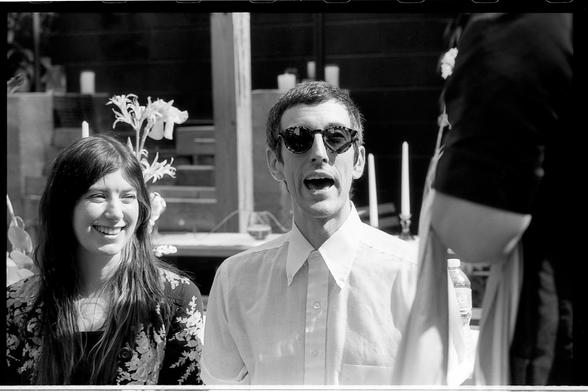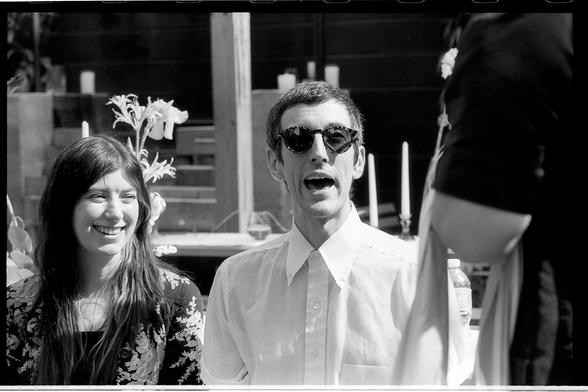These Photos Were Processed In Kodak’s New HC110 In Spite of The Product’s Single Flaw
In early 2019, the film community was pretty stressed out, and with good reason. The nearly two century old chemical manufacturer, Tetenal appeared close to shutting down. Many photographers have probably never even heard of this company, but Tetenal has been "the man behind the curtain" for many of Kodak's products for decades.
The product that Tetenal made that is close to the heart of my work was Kodak HC110, a classic, flexible b&w film developer that is ideal for producing high acutance negatives and push processing while retaining detail.
The possibility of running out of HC110 and having to adopt a new go-to developer was a scary proposition with paid photography work lined up for 2019. Though I'm not a fan of panic-buying, I decided to stock up on Catalog #501-0541 HC110 to get in front of any shortages.
I breathed a sigh of relief when, before the end of 2019, Kodak released a new HC110 formula to address the Tetenal supply interruption and probably other economic reasons.
But how would this new HC110 differ from the old one?
I bought three or four bottles of the new HC110 formula Catalog #105-8692 from Film Photography Project shortly after reading Leslie Lazenby's confidence-instilling article regarding her preliminary testing. While I encourage everyone to read her detailed report, for the purposes of this article, spoiler alert, Leslie concluded that there was no practical difference in the formulae. This new HC110 can be used at precisely the same times and temperatures at the old HC110.
Left to Right: A spent bottle of NEW HC110, My last bottle of OLD HC110 and an unopened bottle of NEW HC110 | © 2021 Johnny Martyr
The old HC110 Catalog #501-0541 has been being made in Germany, in a translucent squared off 1 liter bottle for about as long as Kodak Alaris has been in charge. This formula so far as I know, had been the same for decades. Film shooters recognize it for having a pronounced yellow color and maple syrupy viscosity.
The new Catalog #105-8692 HC110 is made in the United States and is not syrupy at all - it's pretty watery. And it's color is also not bright yellow. The new HC110 presents like an untrustworthy direct replacement because it looks and pours very differently. But, I trusted Leslie's findings and Kodak's commitment to the film community!
Leica M6 TTL 0.85 | Leitz 90mm Summicron Pre-ASPH | Kodak TMAX 100 | NEW Kodak HC110b | © 2021 Johnny Martyr
During the COVID lockdowns of 2020, with slower business, I took the opportunity to finally crack open this mysterious new HC110 and be sure that it rang true for my particular workflow.
I use HC110 Dilution B primarily with Kodak TMAX 100, Tri-X 400 at both 400 and 1600, and TMAX P3200 at 6400. So the goal was to try the new HC110 with all these and make no changes in how I normally process. Below are my usual times and temps, which I applied to use with the new HC110.
Kodak TMAX 100 - Kodak HC110 Dilution B at 68 ° F for 7 minutes
Kodak Tri-X 400 - Kodak HC110 Dilution B at 68 ° F for 7.5 minutes
Kodak Tri-X 400 at EL 1600 - Kodak HC110 Dilution B at 68 ° F for 16 minutes
Kodak TMAX P3200 at EL 6400 - Kodak HC110 Dilution B at 68 ° F for 11.5 minutes
Now, I didn't go to the trouble of processing side-by-side sample images in both the old and new developer but I am confident that after nearly two decades of use, I understand how HC110 performs to notice an appreciable difference.
Leica M6 TTL 0.85 | Leitz 90mm Summicron Pre-ASPH | Kodak TMAX 100 | NEW Kodak HC110b | © 2021 Johnny Martyr
I can happily say that, like Leslie, I saw absolutely zero differences in my results with this watery new American HC110. There are, however, a few differences in use that I'd like to discuss.
The first thing, of course, is the viscosity. Those of us who spent years using HC110 might have an odd emotional attachment to the syrup, but in all reality, the new HC110 pours and mixes faster and probably more thoroughly. There is no more up-ending the bottle and waiting tediously for the very last drops to fall into the graduate. Working with the new HC110 is more like working with liquid Kodafix or Stop in regards to its viscosity. This isn't a big deal but it's a small advantage in my eyes.
Leica M6 TTL 0.85 | Leitz 90mm Summicron Pre-ASPH | Kodak TMAX 100 | NEW Kodak HC110b | © 2021 Johnny Martyr 1930 Leica III | Leitz 5cm f2 Summar | Kodak Tri-X 400 | NEW Kodak HC110b | © 2021 Johnny Martyr
The other difference that I found is a bit of a concern.
I burned through a couple bottles of the new HC110 during the spring and summer of 2020 as I churned through some backlog and new personal images, continuing to do client work in old HC110. Everything went smoothly.
I opened a bottle of the new Catalog #105-8692 HC110 on February 13th, 2021. I used it for a few sessions that continued to go smoothly. But then, on May 4th, 2021, about three cold/cool months since I opened this bottle (manufactured 08/10/2020 with an expiration date of 08/2022, Batch #11697), I first noticed something odd.
I picked up the bottle of new HC110 and heard a light clinking in the bottom of the bottle that sounded like ice cubes in a drink. I looked and could see some white/yellow/brown chunks of crystal settled in the bottle.
I was careful not to pour the crystals into my graduate, allowing them to collect at the neck area of the bottle without actually coming out. This method worked fine and the film that I processed came out just as it should.
Leica M6 TTL 0.85 | Leitz 90mm Summicron Pre-ASPH | Kodak Tri-X 400 | NEW Kodak HC110b | © 2021 Johnny Martyr
I did a little reading and found that some other folks have had this issue and others have not. In fact, Leslie's original article didn't mention them. I reached out to her to see if she had these elusive, mysterious HC110 crystals by now also.
" Yes I have them. I warmed the bottle and much of it dissolved back into the solution, but not all. I suspect they will come back as it sits and cools. I usually give the bottle one gentle inversion before use and they immediately went to the bottom and since I draw my chemistry from the top [using a syringe] it is not a bother. Rather than filter them out I would leave them there."
Nikon FM2n | Nikkor 55mm 2.8 AIS | Kodak Tri-X 400 rated at & processed for 1600 | NEW Kodak HC110b | © 2021 Johnny Martyr
Elsewhere I read that the Kodak Alaris customer support told inquiring folks that the crystals are comprised of potassium salt and are not a problem so long as they do not leave the bottle. I decided to reach out to Michael Seaberg of Kodak's chemical division, SinoPromise Group. I told Mr. Seaberg about my recent experience, to which he replied:
" We have advised other customers that the product is ok to use by decanting the liquid, and it is good you found this by your own testing. We think the issue is solved in our newer batches but need extended keeping time to confirm."
I asked if there was some way that film shooters could identify if their HC110 might be affected by crystal formation.
" I checked on [your] batch number [Batch #11697] which was made in August 2020. We made an adjustment after this batch so batches with expiration of 08/2022 or earlier, under certain conditions, could crystallize. The next batch we made has an expiration of 11/2022 and we have made three more batches thus far in 2021 (with expiration dates of 2023)."
Nikon F2sb | Nikkor 50mm 1.4 S.C. Pre-AI |Kodak TMAX P3200 rated at & processed for 6400 | NEW Kodak HC110b | © 2021 Johnny Martyr Nikon F2sb | Nikkor 50mm 1.4 S.C. Pre-AI | Kodak TMAX P3200 rated at & processed for 6400 | NEW Kodak HC110b | © 2021 Johnny Martyr
Feeling pretty confident with my tests on personal photos, I went ahead and began processing client photos with the new HC110, both before and after crystal formation. The photos featured in this article were all processed with a bottle of HC110 AFTER the crystals had formed. Yet all my results have been excellent and consistent - insofar as the development anyway. The photographer, however, could always use some improvement!
But my point is, if you have some New HC110, are considering buying it, or have already found crystals in your bottle, don 't panic! It's alright! Kodak is taking care of it and your photos will turn out wonderfully.
I'll look forward to a crystal-free New HC110 and am happy to hear that Kodak are aware of the issue and have worked to resolve it. I'd be curious if you have found crystals in your new HC110 and what it's expiration is. Or if you share my opinions about its reliability or not. In any case, hopefully these photos and comments will instill some confidence for those who have been questioning the change to their classic Kodak developer.
Thanks for reading and happy shooting!
_Follow, Favorite, Like, Add, Insult, ContactJohnny Martyr _
#filmphotography #kodak #leica #martyrmusings #news #nikon #reviews #weddingphotography #2019 #2020 #2021 #35mm #5cmf2 #90mm #america #barnackleica #blackandwhite #blackandwhite35mmfilm #blackandwhiteweddingphotography #bokeh #catalog1058692 #catalog5010541 #contrast #developer #developing #dilutionb #film #filmdeveloping #filmdevelopingathome #germany #hc110crystal #hc110crystals #hc110dilutionb #hc110problem #hc110sediment #hc110b #kodakhc110 #kodakhc110cystals #kodakhc110issue #kodaktmax #kodaktmax100 #kodaktmaxp3200 #kodaktrix #kodaktrix400 #leicaiii #leicam6 #leicam6ttl #leicasummar #leicasummicron #leitz #leitz90mmsummicron #leitzsummar #newhc110 #newhc110problem #newhc110review #nikkor #nikkormicro55mm28 #nikonfm2 #nikonfm2n #nikor #nixietubeclock #oldhc110 #people #processing #sinopromise #sinopromisegroup #summicron #tetenal #unitedstates #wedding #weddingphotographyonfilm #weddingreception #wine







